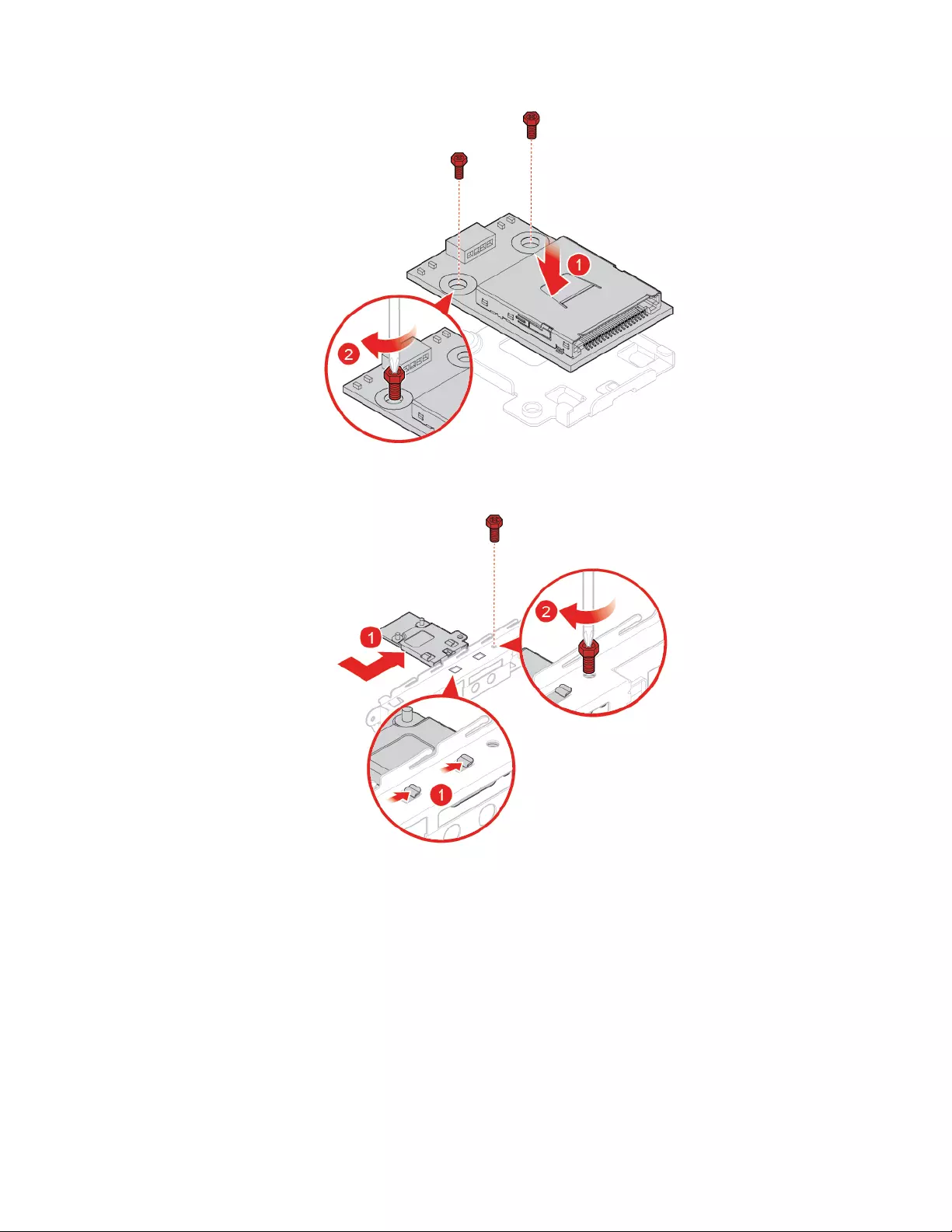Table of Contents
- Chapter 1. Overview
- Chapter 2. Specifications
- Chapter 3. Computer locks
- Chapter 4. Replacing hardware
- Before replacing hardware
- Knowing FRUs (including CRUs)
- Locating FRUs (including CRUs)
- Replacing the power cord
- Replacing the external options
- Removing the computer cover
- Replacing the front bezel
- Replacing the optical drive
- Pivoting the drive bay assembly upward and downward
- Replacing the internal speaker
- Replacing the illuminated red dot
- Replacing the thermal sensor
- Replacing the front I/O options
- Replacing the storage drive
- Replacing the memory module
- Replacing the heat sink and fan assembly
- Replacing the microprocessor
- Replacing a PCI Express card
- Replacing the E-lock
- Replacing the cover presence switch
- Replacing the Wi-Fi card
- Replacing the Wi-Fi antennas
- Replacing the coin-cell battery
- Replacing the M.2 storage drive
- Replacing the M.2 storage drive bracket
- Replacing the power supply assembly
- Replacing the system board
- Completing the parts replacement
- Appendix A. Notices
- Appendix B. Trademarks
Lenovo M920s User Manual
Displayed below is the user manual for M920s by Lenovo which is a product in the PCs/Workstations category. This manual has pages.
Related Manuals

M920s User Guide and Hardware
Maintenance Manual
Energy Star Machine Types: 10SJ, 10SK, 10SL, 10TN, 10U2 and
10U3

Note: Before using this information and the product it supports, be sure to read and understand the
Important Product Information Guide and Appendix A “Notices” on page 65.
Second Edition (August 2019)
© Copyright Lenovo 2018, 2019.
LIMITED AND RESTRICTED RIGHTS NOTICE: If data or software is delivered pursuant to a General Services
Administration “GSA” contract, use, reproduction, or disclosure is subject to restrictions set forth in Contract No. GS-
35F-05925.

Contents
Chapter 1. Overview. . . . . . . . . . . 1
Front view . . . . . . . . . . . . . . . . . . 1
Rear view . . . . . . . . . . . . . . . . . . 3
System board . . . . . . . . . . . . . . . . 5
Machine type and model label . . . . . . . . . . 6
Chapter 2. Specifications . . . . . . . . 7
Chapter 3. Computer locks . . . . . . . 9
Enabling or disabling the E-lock . . . . . . . . . 9
Locking the computer cover . . . . . . . . . . 10
Attaching a Kensington-style cable lock . . . . . 10
Attaching a cable lock . . . . . . . . . . . . 11
Chapter 4. Replacing hardware . . . . 13
Before replacing hardware . . . . . . . . . . 13
Knowing FRUs (including CRUs) . . . . . . . . 13
Locating FRUs (including CRUs) . . . . . . . . 14
Replacing the power cord . . . . . . . . . . . 16
Replacing the external options . . . . . . . . . 17
Removing the computer cover . . . . . . . . . 19
Replacing the front bezel . . . . . . . . . . . 20
Replacing the optical drive . . . . . . . . . . 21
Pivoting the drive bay assembly upward and
downward . . . . . . . . . . . . . . . . . 23
Replacing the internal speaker . . . . . . . . . 24
Replacing the illuminated red dot . . . . . . . . 27
Replacing the thermal sensor . . . . . . . . . 28
Replacing the front I/O options . . . . . . . . . 31
Replacing the storage drive . . . . . . . . . . 34
Replacing the memory module . . . . . . . . . 40
Replacing the heat sink and fan assembly . . . . 41
Replacing the microprocessor . . . . . . . . . 43
Replacing a PCI Express card . . . . . . . . . 45
Replacing the E-lock . . . . . . . . . . . . . 46
Replacing the cover presence switch . . . . . . 47
Replacing the Wi-Fi card . . . . . . . . . . . 48
Replacing the Wi-Fi antennas . . . . . . . . . 52
Replacing the coin-cell battery . . . . . . . . . 54
Replacing the M.2 storage drive . . . . . . . . 56
Replacing the M.2 storage drive bracket . . . . . 58
Replacing the power supply assembly . . . . . . 59
Replacing the system board . . . . . . . . . . 61
Completing the parts replacement . . . . . . . 62
Appendix A. Notices. . . . . . . . . . 65
Appendix B. Trademarks . . . . . . . 67
© Copyright Lenovo 2018, 2019 i

ii M920s User Guide and Hardware Maintenance Manual

Chapter 1. Overview
This chapter provides basic information to help you get familiar with your computer.
Front view
Note: Your computer model might look slightly different from the illustration.
Figure 1. Front view
1 Optical drive eject/close button (optional) 2 Optical drive status indicator (optional)
3 Storage drive activity indicator 4 Card reader (optional)
5 USB-C™ connector (only supports USB data
transmission)
6 Power button
7 Power indicator 8 Microphone connector
9 Headset connector 10 USB 3.1 Gen 1 connectors (2)
11 USB 3.1 Gen 2 connectors (2) 12 Illuminated red dot
13 Internal speaker
1 Optical drive eject/close button
© Copyright Lenovo 2018, 2019 1

Used to eject the tray of the optical drive. After you insert a disc into the tray, press the eject/close button to
close the tray.
2 Optical drive activity indicator
This indicator is on when the optical drive is in use.
3 Storage drive activity indicator
This indicator is on when the storage drive is in use.
4 Card reader slot
Used to read data from a supported memory card.
5 USB-C connector (only supports USB data transmission)
Use the connector to transfer data (USB 3.1 Gen 1, 5.0Gbps), charge your device (5V/3A), or connect to
USB-C accessories to help expand your computer functionality. To purchase USB-C accessories, go to:
https://www.lenovo.com/accessories
6 Power button
Used to turn on your computer. When you cannot shut down the computer from the operating system, press
and hold the power button for four or more seconds to turn off the computer.
7 Power indicator
This indicator is on when the computer is on.
8 Microphone connector
Used to connect a microphone to your computer. You can use the microphone to record sounds or interact
with the computer using speech-recognition software.
9 Headset connector
Used to connect headset to your computer.
10 USB 3.1 Gen 1 connectors
Used to connect a USB-compatible device. For optimal data transfer, connect a USB 3.1 Gen 1 device to a
USB 3.1 Gen 2 or USB 3.1 Gen 1 connector instead of a USB 2.0 connector.
11 USB 3.1 Gen 2 connectors
Used to connect a USB-compatible device. For optimal data transfer, connect a USB 3.1 Gen 2 device to a
USB 3.1 Gen 2 connector instead of a USB 3.1 Gen 1 or USB 2.0 connector.
12 Illuminated red dot
This indicator is on when the computer is on.
13 Internal speaker
Used to listen to the sounds from your computer without using a headset or headphones.
2M920s User Guide and Hardware Maintenance Manual

Rear view
Note: Your computer model might look slightly different from the illustration.
Figure 2. Rear view
1 Audio line-out connector 2 VGA-out connector
3 DisplayPort® 1.2 out connector(2) 4 USB 3.1 Gen 1 connector
5 USB 3.1 Gen 1 connectors (3) 6 Serial connector
7 PS/2 mouse connector (optional) 8 PS/2 keyboard connector (optional)
9 Ethernet connector 10 Security-lock slot
11 Padlock loop 12 PCI-Express card area (different cards provide different
connectors)
13 Power cord connector
1 Audio line-out connector
Used to send audio signals from the computer to external devices, such as powered stereo speakers,
headphones, or multimedia keyboards. To connect a stereo system or other external recording device,
connect a cable between the audio line-in connector of the device and the audio line-out connector of the
computer.
Chapter 1.Overview 3

Note: If your computer has both an audio line-out connector and a headset or headphone connector, always
use the headset connector or headphone connector for earphones, headphones, or a headset. The
headphone connector does not support headset microphones.
2 VGA-out connector
Used to send video signals from the computer to another video device, such as a monitor.
3 DisplayPort 1.2 out connector
Used to send audio and video signals from the computer to another audio or video device, such as a high-
performance monitor.
4 USB 3.1 Gen 1 connector
Used to connect a USB-compatible device. For optimal data transfer, connect a USB 3.1 Gen 1 device to a
USB 3.1 Gen 2 or USB 3.1 Gen 1 connector instead of a USB 2.0 connector. This connector supports the
smart power on feature that enables you to turn on the computer or wake it up from S4 hibernation mode by
pressing Alt+P on the keyboard. You can enable or disable the smart power on feature from the Setup Utility
program. For detailed information, see the Important Product Information Guide.
5 USB 3.1 Gen 1 connectors
Used to connect a USB-compatible device. For optimal data transfer, connect a USB 3.1 Gen 1 device to a
USB 3.1 Gen 2 or USB 3.1 Gen 1 connector instead of a USB 2.0 connector.
6 Serial connector
Used to connect an external modem, a serial printer, or other devices that use a serial connector.
7 PS/2 mouse connector
Used to connect a mouse, a trackball, or other pointing devices that use a PS/2 mouse connector.
8 PS/2 keyboard connector
Used to connect a keyboard that uses a Personal System/2 (PS/2) keyboard connector.
9 Ethernet connector
Used to connect an Ethernet cable for network access.
10 Security-lock slot
Used to secure a Kensington-style cable lock.
11 Padlock loop
Used to secure a padlock.
12 PCI-Express card area
To improve the operating performance of the computer, you can connect PCI-Express cards into this area.
Depending on the computer model, the connectors in this area vary.
13 Power cord connector
4M920s User Guide and Hardware Maintenance Manual

Used to connect the power cord to your computer for power supply.
System board
Note: See “Front view” on page 1 and “Rear view” on page 3 for additional component descriptions.
Figure 3. System board
1 4-pin power connector 2 Microprocessor fan connector
3 Memory slot (DIMM1) 4 Memory slot (DIMM2)
5 Memory slot (DIMM3) 6 Memory slot (DIMM4)
7 Power button board connector 8 Internal speaker connector
9 10-pin power connector 10 SATA power connector
11 SATA power connector 12 Auxiliary fan connector
13 SATA 3.0 connector 14 SATA 3.0 connector
15 SATA 3.0 connector 16 Clear CMOS jumper
17 SATA 3.0 connector 18 M.2 storage drive slot
19 M.2 Wi-Fi card slot 20 Thermal sensor connector
21 Illuminated red dot connector 22 Front USB 2.0 connector
23 Front USB 2.0 connector 24 Serial connector (optional)
25 Thunderbolt connector 26 PCI Express card slot (physical link width x16;
negotiable link width x4, x1)
27 PCI Express x1 card slot 28 PCI Express x16 graphics card slot
Chapter 1.Overview 5

29 E-lock connector 30 System fan connector
31 Cover presence switch 32 Coin-cell battery
33 Microprocessor socket 34 PS/2 keyboard and mouse connector
Machine type and model label
The machine type and model label identifies the computer. When you contact Lenovo for help, the machine
type and model information helps support technicians to identify the computer and provide faster service.
The machine type and model label is attached on the side of the computer as shown.
Figure 4. Machine type and model label
6M920s User Guide and Hardware Maintenance Manual

Chapter 2. Specifications
Power supply
• 180 watt automatic voltage-sensing power supply
• 210 watt automatic voltage-sensing power supply
• 260 watt automatic voltage-sensing power supply
Storage drives
Up to two SATA storage drives and one M.2 storage drive
Video features
• The integrated graphics card supports the following:
– DisplayPort-out connector
– VGA-out connector
• The optional discrete graphics card provides an enhanced video experience and extended capabilities.
Audio features
• The integrated audio card supports the following:
– Audio line-out connector
– Headset connector
– Internal speaker
– Microphone connector
• The optional discrete audio card provides an enhanced audio experience and extended capabilities.
Input/Output (I/O) features
• Audio connectors (audio line-out connector, headset connector, and microphone connector)
• Card reader slot (optional)
• Display connectors (DisplayPort-out connector and VGA-out connector)
• Ethernet connector
• PS/2 keyboard connector (optional)
• PS/2 mouse connector (optional)
• Serial connector
• USB connectors
Expansion
• Card reader (optional)
• Memory slot
• Optical drive (optional)
• PCI Express card slot (physical link width x16; negotiable link width x4, x1)
• PCI Express x1 card slot
• PCI Express x16 graphics card slot
• Storage drive bay
© Copyright Lenovo 2018, 2019 7

Network features
• Ethernet LAN
• Wireless LAN (optional)
• Bluetooth (optional)
Physical dimensions
• Width: 92.5 mm (3.6 inches)
• Height: 343.5 mm (13.5 inches)
• Depth: 290.5 mm (11.4 inches)
Weight (without the package)
Maximum configuration as shipped: 6.0 kg (13.2 lb)
Statement on USB transfer rate
Depending on many factors such as the processing capability of the host and peripheral devices, file
attributes, and other factors related to system configuration and operating environments, the actual transfer
rate using the various USB connectors on this device will vary and will be slower than the data rate listed
below for each corresponding device.
USB device Data rate (Gbit/s)
3.1 Gen 1 5
3.1 Gen 2 10
3.2 20
8M920s User Guide and Hardware Maintenance Manual

Chapter 3. Computer locks
This chapter provides instructions on how to lock your computer with the locking devices to keep your
computer safe.
Enabling or disabling the E-lock
Your computer may have a security lock solution installed to protect the computer from unauthorized
tampering of the internal components. Using the E-Lock, you can mechanically lock or unlock the computer
cover.
To enable or disable the E-Lock, do the following:
1. Turn on or restart the computer.
2. Before Windows starts up, repeatedly press and release the F1 or Fn+F1 key until the Setup Utility
program opens.
3. Click Security ➙ Electronic Lock to enable or disable the E-lock.
4. Press F10 or Fn+F10 to save the changes and reboot the computer.
Note: Changes do not take effect until the setting is saved and the system is rebooted.
Figure 5. Enabling or disabling the E-lock
© Copyright Lenovo 2018, 2019 9
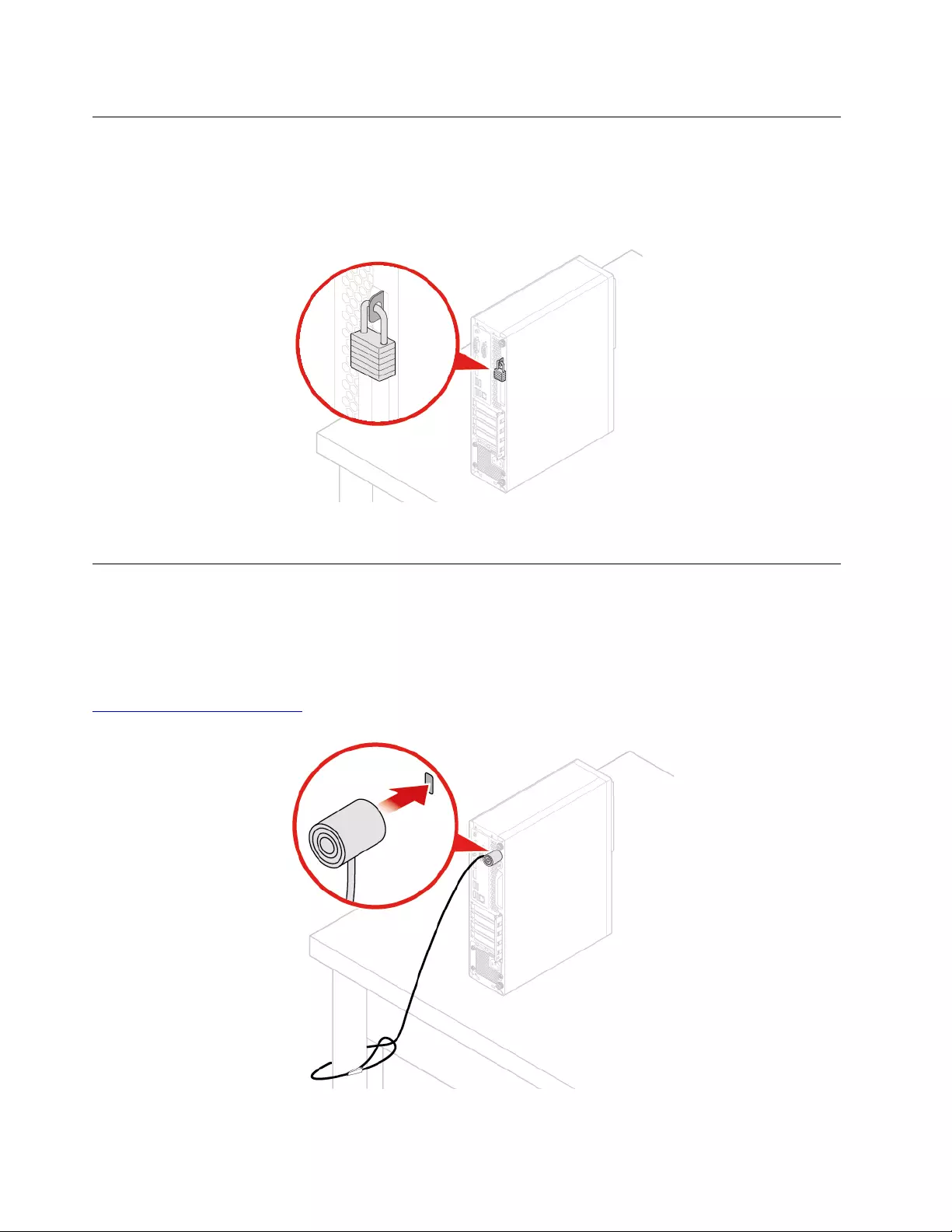
Locking the computer cover
Locking the computer cover helps prevent unauthorized access to the inside of your computer. Your
computer features a padlock loop so that the computer cover cannot be removed when a padlock is
installed.
Figure 6. Locking the computer cover
Attaching a Kensington-style cable lock
You can use a Kensington-style cable lock to secure your computer to a desk, table, or other nonpermanent
fixture. The cable lock connects to the security-lock slot at the rear of your computer. Depending on the type
selected, the cable lock can be operated with a key or combination. The cable lock also locks the buttons
used to open the computer cover. This is the same type of lock used with many notebook computers. You
can order such a cable lock directly from Lenovo by searching for Kensington at:
http://www.lenovo.com/support
Figure 7. Attaching a Kensington-style cable lock
10 M920s User Guide and Hardware Maintenance Manual
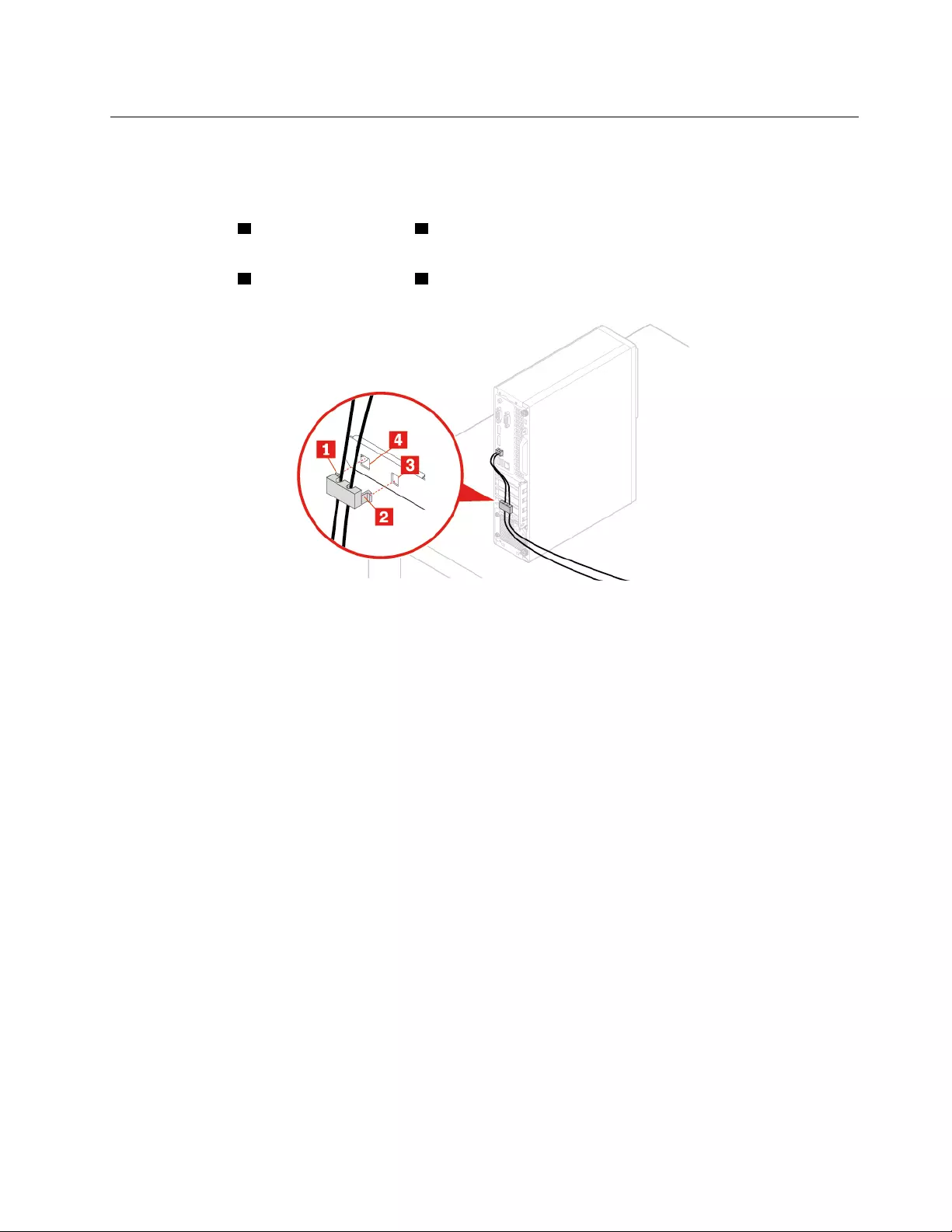
Attaching a cable lock
A cable lock can be used to secure devices, such as the keyboard and the mouse, by locking the device
cables to the computer. The cable lock connects to the cable-lock slots on the rear of the computer. To
install a cable lock, do the following:
1. Insert the clip 1 into the cable-lock slot 4.
2. Pull the cables you want to lock through the dents in the cable lock.
3. Press the clip 2 into the cable-lock slot 3 until it snaps into position.
Figure 8. Attaching a cable lock
Chapter 3.Computer locks 11

12 M920s User Guide and Hardware Maintenance Manual

Chapter 4. Replacing hardware
This chapter provides instructions on how to replace hardware for your computer.
Before replacing hardware
Attention: Do not open your computer or attempt any repairs before reading this section and the Important
Product Information Guide.
Notes before replacing hardware
• Use computer components provided only by Lenovo.
• When installing or replacing an option, use the appropriate instructions explained in this manual along with
the instructions that come with the option.
• In most areas of the world, Lenovo requires the return of defective CRUs. Information about this will come
with the CRU or will come a few days after the CRU arrives.
Handling static-sensitive devices
Do not open the static-protective package containing the new part until the defective part has been removed
and you are ready to install the new part. Static electricity, although harmless to you, can seriously damage
computer components and options.
When you handle options and other computer components, take these precautions to avoid static-electricity
damage:
• Limit your movement. Movement can cause static electricity to build up around you.
• Always handle options and other computer components carefully. Handle PCI/PCIe cards, memory
modules, system boards, and microprocessors by the edges. Never touch any exposed circuitry.
• Prevent others from touching the options and other computer components.
• Touch the static-protective package containing the part to a metal expansion-slot cover or other
unpainted metal surface on the computer for at least two seconds. This reduces static electricity from the
package and your body before you install or replace a new part.
• When possible, remove the new part from the static-protective package, and install it directly in the
computer without setting the part down. When this is not possible, place the static-protective package on
a smooth, level surface and place the part on the package.
• Do not place the part on the computer cover or other metal surface.
Knowing FRUs (including CRUs)
• Field Replaceable Units (FRUs) are computer parts that a trained technician can upgrade or replace. FRUs
include all CRUs. For detailed FRU information, such as the FRU part numbers and supported computer
models, go to:
http://www.lenovo.com/serviceparts-lookup
• Customer Replaceable Units (CRUs) are computer parts that a user can upgrade or replace.
– Self-service CRUs: You can install self-service CRUs easily. These CRUs might be stand-alone,
latched, or secured by up to two screws. Examples of self-service CRUs include the keyboard, mouse,
any USB device. You are responsible for replacing all self-service CRUs.
– Optional-service CRUs: Handling optional-service CRUs requires some technical skills and simple tools
(such as a screwdriver). These CRUs are isolated parts within the computer. They are usually
© Copyright Lenovo 2018, 2019 13

concealed by an access panel that is secured by more than two screws. You must remove the screws
and panel to access the specific CRU. Optional-service CRUs can be removed and installed by users
or, during the warranty period, by a Lenovo service technician.
Before replacing FRUs
Before replacing any FRU, read the following:
• Only certified and trained personnel can service the computer.
• Before replacing an FRU, read the entire section about replacing the part.
• Be extremely careful during writing operations such as copying, saving, or formatting.
The sequence of the drives in the computer that you are servicing might have been altered. If you select
an incorrect drive, data or programs might be overwritten.
• Replace an FRU only with another FRU of the correct model.
When you replace an FRU, ensure that the model of the machine and the FRU part number are correct.
• An FRU should not be replaced because of a single, unreproducible failure.
Single failures can occur for a variety of reasons that have nothing to do with a hardware defect, such as
cosmic radiation, electrostatic discharge, or software errors. Consider replacing an FRU only when a
problem recurs. If you suspect that an FRU is defective, clear the error log and run the test again. If the
error does not recur, do not replace the FRU.
• Only replace a defective FRU.
Locating FRUs (including CRUs)
Notes:
• Some of the following components are optional.
• To replace a component that is not in the list below, contact a Lenovo service technician. For a list of
Lenovo Support phone numbers, go to:
http://www.lenovo.com/support/phone
14 M920s User Guide and Hardware Maintenance Manual

Figure 9. Locating FRUs (including CRUs)
Self-service CRUs Optional-service CRUs Non-CRUs
1 Computer cover 7 Wi-Fi card 2 Heat sink and fan assembly
4 Memory module 8 Wi-Fi card shield 3 Microprocessor
6 Coin-cell battery 34 Power supply assembly 5 System board
10 M.2 storage drive 36 E-lock 9 Cover presence switch
11 M.2 storage drive bracket 14 Power button
12 Secondary storage drive bracket 15 Card reader
13 Secondary storage drive (a 2.5-
inch storage drive)
16 Front I/O bracket
Chapter 4.Replacing hardware 15

Self-service CRUs Optional-service CRUs Non-CRUs
18 Optical drive bracket 17 Optical drive cable
19 Optical drive 28 Storage drive cable
20 Front bezel 29 Illuminated red dot
21 Dust shield 30 Thermal sensor
22 Keyboard 31 Internal speaker
23 Mouse 33 Chassis
24 Power cord 35 Wi-Fi antennas
25 Primary storage drive (a 2.5-inch
or 3.5-inch storage drive)
26 Primary storage drive bracket
27 Storage drive converter
32 Vertical stand
37 PCI Express card
Replacing the power cord
Attention: Do not open your computer or attempt any repairs before reading the Important Product
Information Guide.
1. Remove any media from the drives and turn off all connected devices and the computer. Disconnect all
power cords from electrical outlets and disconnect all cables from the computer.
2. Replace the power cord.
Figure 10. Removing the power cord
16 M920s User Guide and Hardware Maintenance Manual

Figure 11. Installing the power cord
Replacing the external options
Attention: Do not open your computer or attempt any repairs before reading the Important Product
Information Guide.
1. Remove any media from the drives and turn off all connected devices and the computer. Disconnect all
power cords from electrical outlets and disconnect all cables from the computer.
2. Refer to the following to replace external options.
• Vertical stand
Figure 12. Removing the vertical stand
Chapter 4.Replacing hardware 17

Figure 13. Assembling the vertical stand
Figure 14. Installing the vertical stand
• Dust shield
18 M920s User Guide and Hardware Maintenance Manual

Figure 15. Removing the dust shield
Figure 16. Installing the dust shield
3. Reconnect all cables.
Removing the computer cover
Attention: Do not open your computer or attempt any repairs before reading the Important Product
Information Guide.
CAUTION:
Before you open the computer cover, turn off the computer and wait several minutes until the
computer is cool.
1. Remove any media from the drives and turn off all connected devices and the computer. Disconnect all
power cords from electrical outlets and disconnect all cables from the computer.
Chapter 4.Replacing hardware 19

2. Unlock any locking device that secures the computer cover.
3. Remove the computer cover.
Figure 17. Removing the computer cover
4. Complete the replacement. See “Completing the parts replacement” on page 62.
Replacing the front bezel
Attention: Do not open your computer or attempt any repairs before reading the Important Product
Information Guide.
1. Remove any media from the drives and turn off all connected devices and the computer. Disconnect all
power cords from electrical outlets and disconnect all cables from the computer.
2. Remove the computer cover. See “Removing the computer cover” on page 19.
3. Replace the front bezel.
20 M920s User Guide and Hardware Maintenance Manual

Figure 18. Removing the front bezel
Figure 19. Installing the front bezel
4. Complete the replacement. See “Completing the parts replacement” on page 62.
Replacing the optical drive
Attention: Do not open your computer or attempt any repairs before reading the Important Product
Information Guide.
Chapter 4.Replacing hardware 21

1. Remove any media from the drives and turn off all connected devices and the computer. Disconnect all
power cords from electrical outlets and disconnect all cables from the computer.
2. Remove the computer cover. See “Removing the computer cover” on page 19.
3. Remove the front bezel. See “Replacing the front bezel” on page 20.
4. Disconnect the signal cable and the power cable from the optical drive.
5. Replace the optical drive.
Figure 20. Removing the optical drive
Figure 21. Removing the optical drive retainer
22 M920s User Guide and Hardware Maintenance Manual

Figure 22. Installing the optical drive retainer
Figure 23. Installing the optical drive
6. Connect the signal cable and the power cable to the new optical drive.
7. Reinstall the removed parts. To complete the replacement, see “Completing the parts replacement” on
page 62.
Pivoting the drive bay assembly upward and downward
Attention: Do not open your computer or attempt any repairs before reading the Important Product
Information Guide.
1. Remove any media from the drives and turn off all connected devices and the computer. Disconnect all
power cords from electrical outlets and disconnect all cables from the computer.
2. Remove the computer cover. See “Removing the computer cover” on page 19.
3. Remove the front bezel. See “Replacing the front bezel” on page 20.
4. Pivot the drive bay assembly upward and downward.
Chapter 4.Replacing hardware 23

Figure 24. Pivoting the drive bay assembly upward
Figure 25. Pivoting the drive bay assembly downward
5. Reinstall the removed parts. To complete the replacement, see “Completing the parts replacement” on
page 62.
Replacing the internal speaker
Attention: Do not open your computer or attempt any repairs before reading the Important Product
Information Guide.
1. Remove any media from the drives and turn off all connected devices and the computer. Disconnect all
power cords from electrical outlets and disconnect all cables from the computer.
24 M920s User Guide and Hardware Maintenance Manual

2. Remove the computer cover. See “Removing the computer cover” on page 19.
3. Remove the front bezel. See “Replacing the front bezel” on page 20.
4. Disconnect the internal speaker cable from the system board.
5. Replace the internal speaker.
Figure 26. Removing the internal speaker screws
Figure 27. Pivoting the drive bay assembly upward
Chapter 4.Replacing hardware 25

Figure 28. Removing the internal speaker
Figure 29. Installing the internal speaker
Figure 30. Installing the internal speaker screws
26 M920s User Guide and Hardware Maintenance Manual
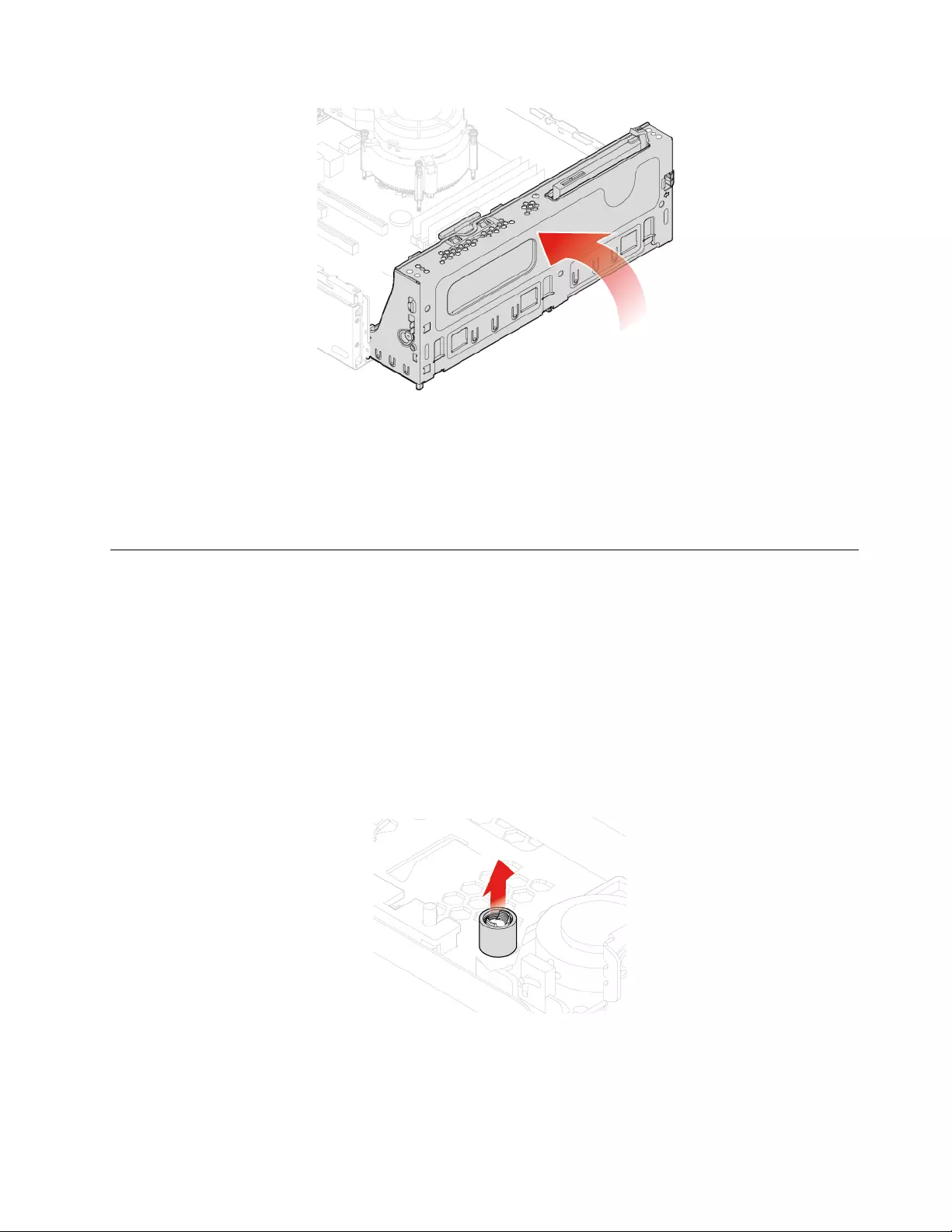
Figure 31. Pivoting the drive bay assembly downward
6. Connect the new internal speaker cable to the system board.
7. Reinstall the removed parts. To complete the replacement, see “Completing the parts replacement” on
page 62.
Replacing the illuminated red dot
Attention: Do not open your computer or attempt any repairs before reading the Important Product
Information Guide.
1. Remove any media from the drives and turn off all connected devices and the computer. Disconnect all
power cords from electrical outlets and disconnect all cables from the computer.
2. Remove the computer cover. See “Removing the computer cover” on page 19.
3. Remove the front bezel. See “Replacing the front bezel” on page 20.
4. Pivot the drive bay assembly upward. See “Pivoting the drive bay assembly upward and downward” on
page 23.
5. Disconnect the illuminated red dot cable from the system board.
6. Replace the illuminated red dot.
Figure 32. Removing the illuminated red dot cover
Chapter 4.Replacing hardware 27

Figure 33. Removing the illuminated red dot
Figure 34. Installing the illuminated red dot
Figure 35. Installing the illuminated red dot cover
7. Connect the new illuminated red dot cable to the system board.
8. Reinstall the removed parts. To complete the replacement, see “Completing the parts replacement” on
page 62.
Replacing the thermal sensor
Attention: Do not open your computer or attempt any repairs before reading the Important Product
Information Guide.
1. Remove any media from the drives and turn off all connected devices and the computer. Disconnect all
power cords from electrical outlets and disconnect all cables from the computer.
2. Remove the computer cover. See “Removing the computer cover” on page 19.
28 M920s User Guide and Hardware Maintenance Manual

Figure 38. Removing the thermal sensor
Figure 39. Installing the thermal sensor
Figure 40. Pivoting the drive bay assembly downward
6. Connect the new thermal sensor cable to the system board.
30 M920s User Guide and Hardware Maintenance Manual

7. Reinstall the removed parts. To complete the replacement, see “Completing the parts replacement” on
page 62.
Replacing the front I/O options
Attention: Do not open your computer or attempt any repairs before reading the Important Product
Information Guide.
1. Remove any media from the drives and turn off all connected devices and the computer. Disconnect all
power cords from electrical outlets and disconnect all cables from the computer.
2. Remove the computer cover. See “Removing the computer cover” on page 19.
3. Remove the front bezel. See “Replacing the front bezel” on page 20.
4. Disconnect the power button board cable and card reader cable from the system board.
5. Replace the front I/O options.
Figure 41. Removing the front I/O bracket
Figure 42. Removing the power button board
Chapter 4.Replacing hardware 31

Figure 43. Removing the card reader bracket
Figure 44. Removing the card reader
32 M920s User Guide and Hardware Maintenance Manual
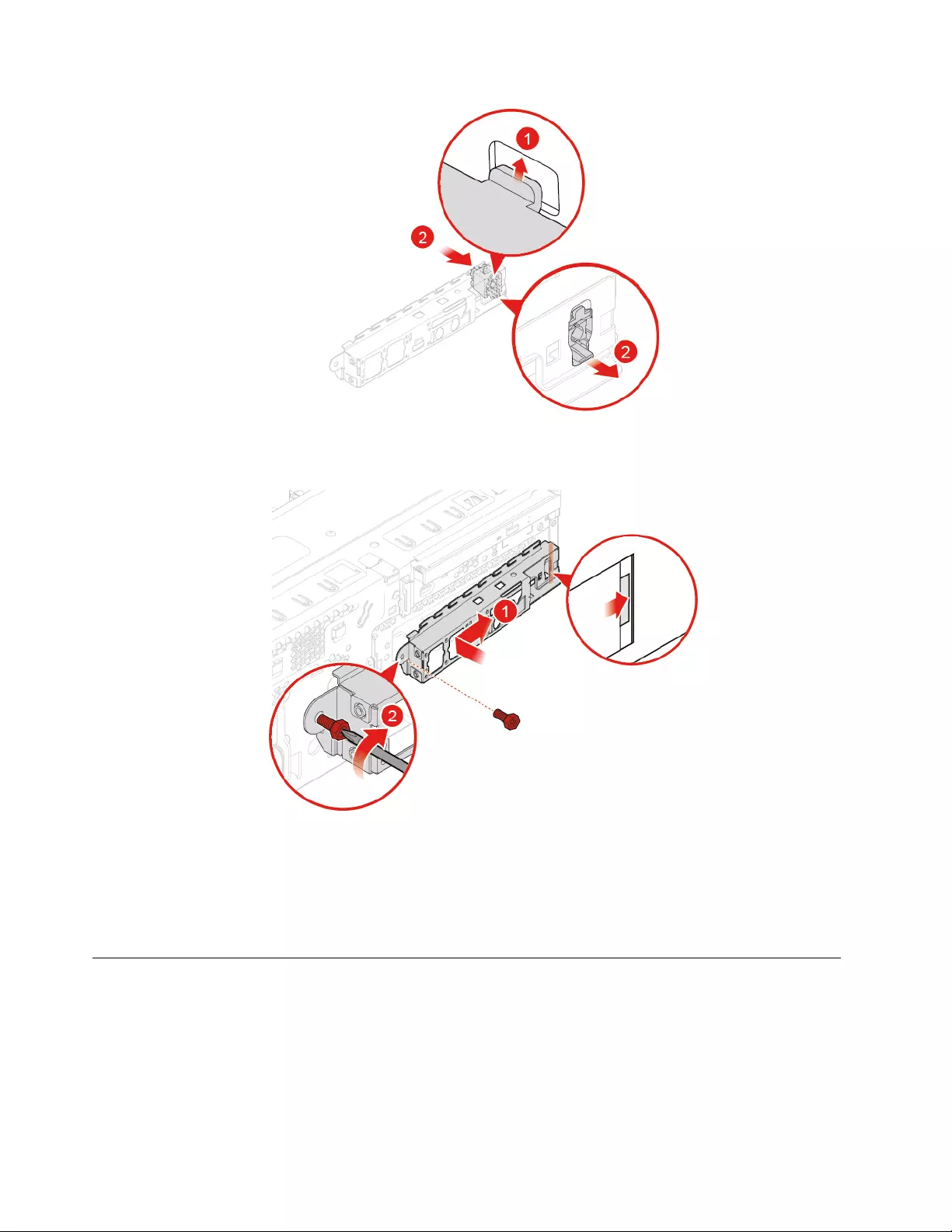
Figure 47. Installing the power button board
Figure 48. Installing the front I/O bracket
6. Connect the new front I/O options cable to the system board.
7. Reinstall the removed parts. To complete the replacement, see “Completing the parts replacement” on
page 62.
Replacing the storage drive
Attention: Do not open your computer or attempt any repairs before reading the Important Product
Information Guide.
Replacing the 3.5-inch primary storage drive
1. Remove any media from the drives and turn off all connected devices and the computer. Disconnect all
power cords from electrical outlets and disconnect all cables from the computer.
34 M920s User Guide and Hardware Maintenance Manual

2. Remove the computer cover. See “Removing the computer cover” on page 19.
3. Remove the front bezel. See “Replacing the front bezel” on page 20.
4. Pivot the drive bay assembly outward. See “Pivoting the drive bay assembly upward and downward” on
page 23.
5. Disconnect the signal cable and the power cable from the 3.5-inch primary storage drive.
6. Replace the 3.5-inch primary storage drive.
Figure 49. Removing the storage drive bracket
Figure 50. Removing the storage drive
Chapter 4.Replacing hardware 35

Figure 51. Installing the storage drive
Figure 52. Installing the storage drive bracket
7. Connect the signal cable and the power cable to the new 3.5-inch storage drive.
8. Reinstall the removed parts. To complete the replacement, see “Completing the parts replacement” on
page 62.
Replacing the 2.5-inch primary storage drive
1. Remove the storage converter with the 2.5-inch primary sstorage drive. See "Replacing the 3.5-inch
primary storage drive".
2. Replace the 2.5-inch primary storage drive in the storage converter.
36 M920s User Guide and Hardware Maintenance Manual

Figure 53. Removing the storage drive
Figure 54. Installing the storage drive
3. Reinstall the storage converter with the 2.5-inch primary storage drive. See "Replacing the 3.5-inch
primary storage drive".
Replacing the 2.5-inch secondary storage drive
1. Remove any media from the drives and turn off all connected devices and the computer. Disconnect all
power cords from electrical outlets and disconnect all cables from the computer.
2. Remove the computer cover. See “Removing the computer cover” on page 19.
3. Remove the front bezel. See “Replacing the front bezel” on page 20.
Chapter 4.Replacing hardware 37

4. Pivot the drive bay assembly outward. See “Pivoting the drive bay assembly upward and downward” on
page 23.
5. Disconnect the signal cable and the power cable from the 2.5-inch secondary storage drive.
6. Replace the 2.5-inch secondary storage drive.
Figure 55. Removing the outer storage drive bracket
Figure 56. Removing the inner storage drive bracket
38 M920s User Guide and Hardware Maintenance Manual

Figure 60. Installing the outer storage drive bracket
7. Connect the signal cable and the power cable to the new 2.5-inch secondary storage drive.
8. Reinstall the removed parts. To complete the replacement, see “Completing the parts replacement” on
page 62.
Replacing the memory module
Attention: Do not open your computer or attempt any repairs before reading the Important Product
Information Guide.
Ensure that you follow the order of installing memory modules shown in the following figure.
Figure 61. The order of installing memory modules
40 M920s User Guide and Hardware Maintenance Manual

1. Remove any media from the drives and turn off all connected devices and the computer. Disconnect all
power cords from electrical outlets and disconnect all cables from the computer.
2. Remove the computer cover. See “Removing the computer cover” on page 19.
3. Remove the front bezel. See “Replacing the front bezel” on page 20.
4. Pivot the drive bay assembly upward. See “Pivoting the drive bay assembly upward and downward” on
page 23.
5. Replace the memory module.
Figure 62. Removing the memory module
Figure 63. Installing the memory module
6. Reinstall the removed parts. To complete the replacement, see “Completing the parts replacement” on
page 62.
Replacing the heat sink and fan assembly
Attention: Do not open your computer or attempt any repairs before reading the Important Product
Information Guide.
CAUTION:
The heat sink and fan assembly might be very hot. Before you open the computer cover, turn off the
computer and wait several minutes until the computer is cool.
Chapter 4.Replacing hardware 41

1. Remove any media from the drives and turn off all connected devices and the computer. Disconnect all
power cords from electrical outlets and disconnect all cables from the computer.
2. Remove the computer cover. See “Removing the computer cover” on page 19.
3. Remove the front bezel. See “Replacing the front bezel” on page 20.
4. Pivot the drive bay assembly upward. See “Pivoting the drive bay assembly upward and downward” on
page 23.
5. Disconnect the heat sink and fan assembly cable from the system board.
6. Replace the heat sink and fan assembly.
Figure 64. Removing the heat sink and fan assembly
Figure 65. Installing the heat sink and fan assembly
7. Connect the new heat sink and fan assembly cable to the system board.
42 M920s User Guide and Hardware Maintenance Manual

8. Reinstall the removed parts. To complete the replacement, see “Completing the parts replacement” on
page 62.
Replacing the microprocessor
Attention: Do not open your computer or attempt any repairs before reading the Important Product
Information Guide.
CAUTION:
The heat sink and microprocessor might be very hot. Before you open the computer cover, turn off the
computer and wait several minutes until the computer is cool.
1. Remove the computer cover. See “Removing the computer cover” on page 19.
2. Remove the front bezel. See “Replacing the front bezel” on page 20.
3. Pivot the drive bay assembly upward. See “Pivoting the drive bay assembly upward and downward” on
page 23.
4. Remove the heat sink and fan assembly. See “Replacing the heat sink and fan assembly” on page 41.
5. Disconnect all cables connected to the system board.
6. Replace the microprocessor.
Notes:
• Your microprocessor and socket might look different from the one illustrated.
• Touch only the edges of the microprocessor. Do not touch the gold contacts on the bottom.
• Do not drop anything onto the microprocessor socket while it is exposed. The socket pins must be
kept as clean as possible.
Figure 66. Releasing the holder
Figure 67. Pivoting up the socket
Chapter 4.Replacing hardware 43

Figure 68. Removing the microprocessor
Figure 69. Installing the microprocessor
Figure 70. Pivoting the socket downward
44 M920s User Guide and Hardware Maintenance Manual
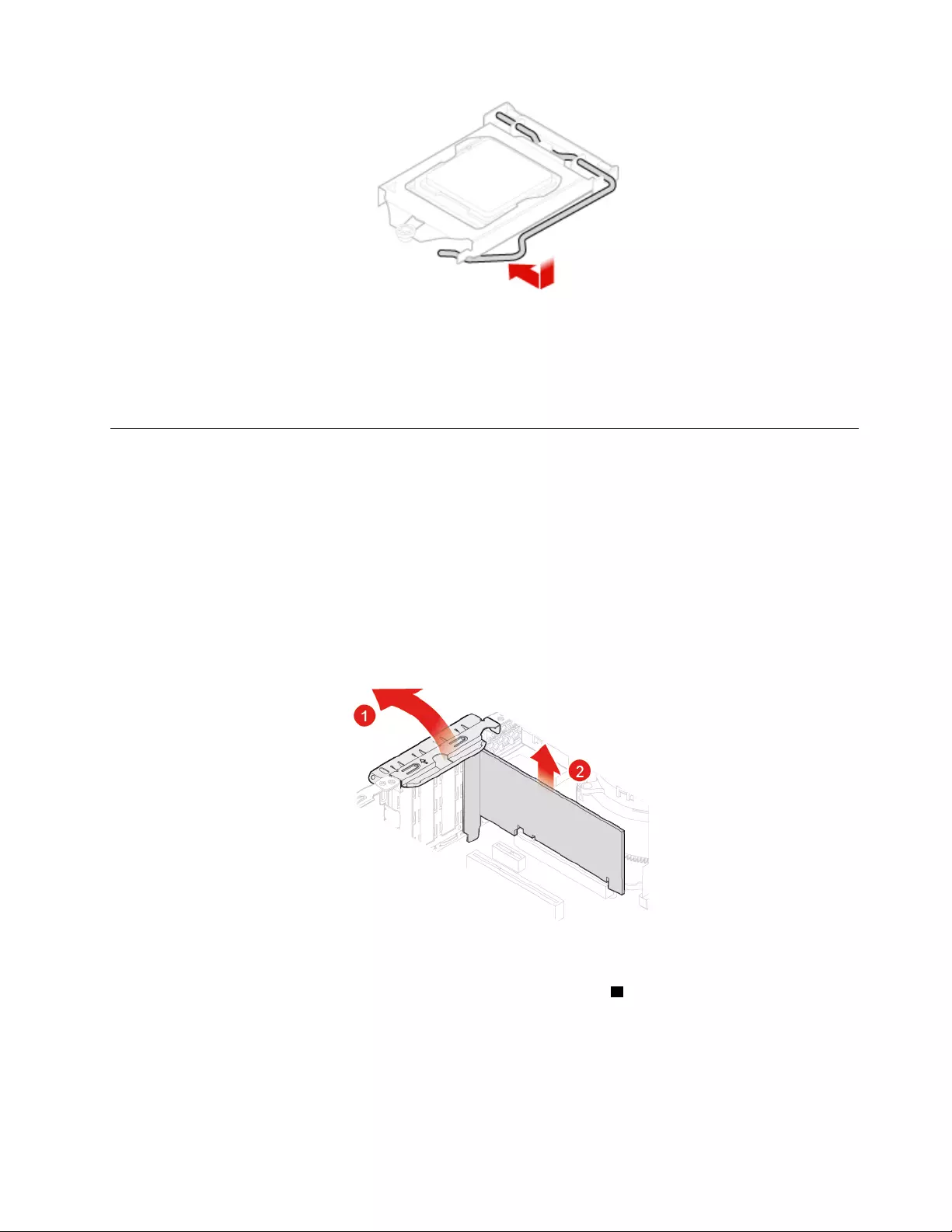
Figure 71. Securing the holder
7. Reconnect all cables that were disconnected from the system board.
8. Reinstall the removed parts. To complete the replacement, see “Completing the parts replacement” on
page 62.
Replacing a PCI Express card
Attention: Do not open your computer or attempt any repairs before reading the Important Product
Information Guide.
1. Remove any media from the drives and turn off all connected devices and the computer. Disconnect all
power cords from electrical outlets and disconnect all cables from the computer.
2. Remove the computer cover. See “Removing the computer cover” on page 19.
3. Remove the front bezel. See “Replacing the front bezel” on page 20.
4. Pivot the drive bay assembly upward. See “Pivoting the drive bay assembly upward and downward” on
page 23.
5. Replace a PCI Express card.
Figure 72. Removing a PCI Express card
Note: If the card is held in place by a retaining latch, press the latch 1 as shown to disengage the latch.
Then, gently remove the card from the slot.
Chapter 4.Replacing hardware 45

Figure 73. Installing a PCI Express card
6. Reinstall the removed parts. To complete the replacement, see “Completing the parts replacement” on
page 62.
Replacing the E-lock
Attention: Do not open your computer or attempt any repairs before reading the Important Product
Information Guide.
Note: To remove the screws, you need a special tool (T15 star wrench).
1. Remove any media from the drives and turn off all connected devices and the computer. Disconnect all
power cords from electrical outlets and disconnect all cables from the computer.
2. Remove the computer cover. See “Removing the computer cover” on page 19.
3. Disconnect the E-lock cable from the system board.
4. Replace the E-lock.
46 M920s User Guide and Hardware Maintenance Manual

Figure 74. Removing the E-lock
Figure 75. Installing the E-lock
5. Reinstall the removed parts. To complete the replacement, see “Completing the parts replacement” on
page 62.
Replacing the cover presence switch
Attention: Do not open your computer or attempt any repairs before reading the Important Product
Information Guide.
1. Remove any media from the drives and turn off all connected devices and the computer. Disconnect all
power cords from electrical outlets and disconnect all cables from the computer.
2. Remove the computer cover. See “Removing the computer cover” on page 19.
3. Disconnect the cover presence switch cable from the system board.
4. Replace the cover presence switch.
Chapter 4.Replacing hardware 47

Figure 76. Removing the cover presence switch
Figure 77. Installing the cover presence switch
5. Connect the new cover presence switch cable to the system board.
6. Reinstall the removed parts. To complete the replacement, see “Completing the parts replacement” on
page 62.
Replacing the Wi-Fi card
Attention: Do not open your computer or attempt any repairs before reading the Important Product
Information Guide.
1. Remove any media from the drives and turn off all connected devices and the computer. Disconnect all
power cords from electrical outlets and disconnect all cables from the computer.
2. Remove the computer cover. See “Removing the computer cover” on page 19.
3. Remove the front bezel. See “Replacing the front bezel” on page 20.
4. Pivot the drive bay assembly upward. See “Pivoting the drive bay assembly upward and downward” on
page 23.
5. Replace the Wi-Fi card.
48 M920s User Guide and Hardware Maintenance Manual

Figure 81. Installing the Wi-Fi card
Figure 82. Connecting the antennas
Figure 83. Installing the Wi-Fi card shield
• Type 2
50 M920s User Guide and Hardware Maintenance Manual

Figure 87. Installing the Wi-Fi card
Figure 88. Connecting the antennas
Figure 89. Installing the Wi-Fi card shield
6. Reinstall the removed parts. To complete the replacement, see “Completing the parts replacement” on
page 62.
Replacing the Wi-Fi antennas
Attention: Do not open your computer or attempt any repairs before reading the Important Product
Information Guide.
1. Remove any media from the drives and turn off all connected devices and the computer. Disconnect all
power cords from electrical outlets and disconnect all cables from the computer.
2. Remove the computer cover. See “Removing the computer cover” on page 19.
52 M920s User Guide and Hardware Maintenance Manual

3. Remove the front bezel. See “Replacing the front bezel” on page 20.
4. Pivot the drive bay assembly upward. See “Pivoting the drive bay assembly upward and downward” on
page 23.
5. Disconnect the antenna cables from the Wi-Fi card.
6. Replace the Wi-Fi antennas.
• Front Wi-Fi antenna
Figure 90. Removing the Wi-Fi antenna
Figure 91. Installing the Wi-Fi antenna
• Rear Wi-Fi antenna
Chapter 4.Replacing hardware 53
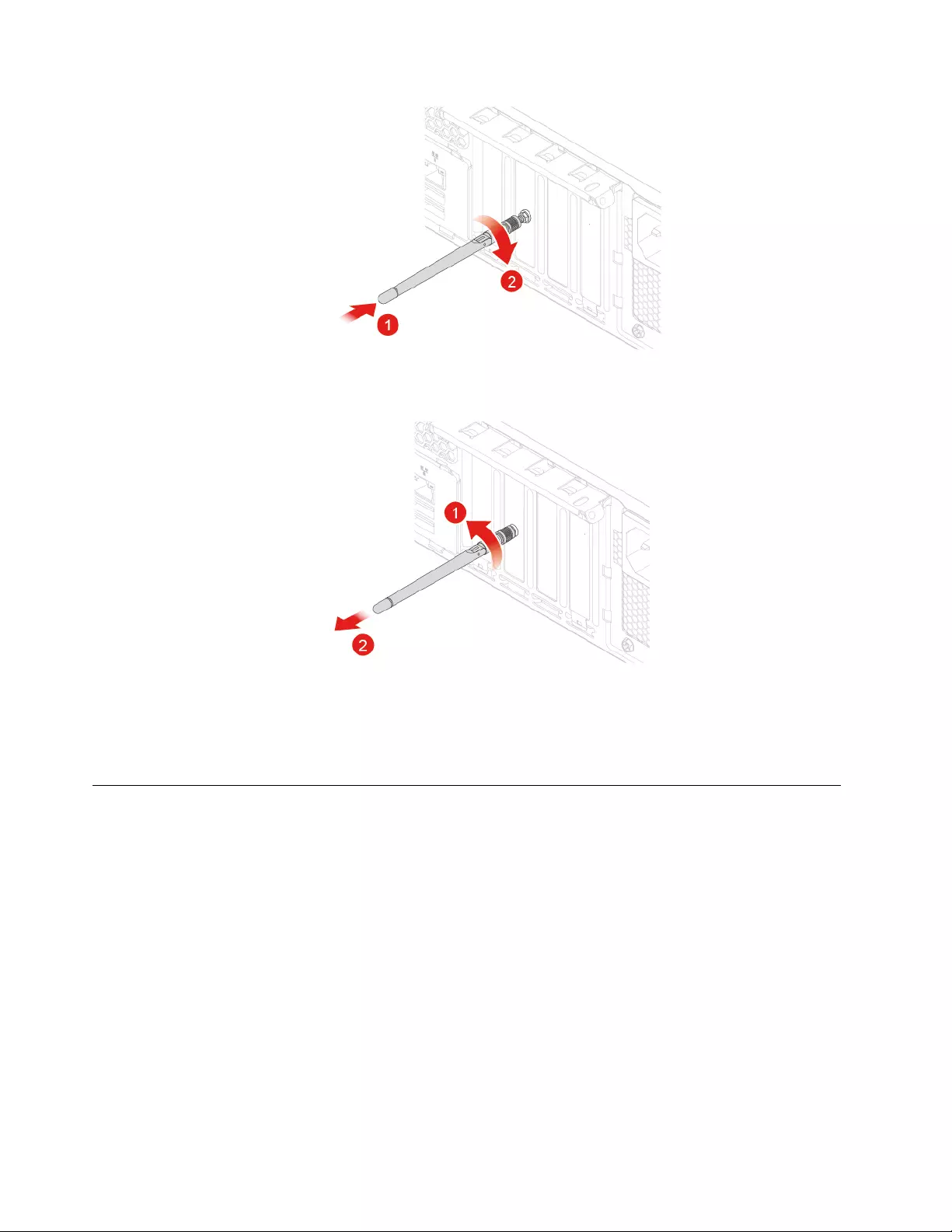
Figure 92. Removing the Wi-Fi antenna
Figure 93. Installing the Wi-Fi antenna
7. Reinstall the removed parts. To complete the replacement, see “Completing the parts replacement” on
page 62.
Replacing the coin-cell battery
Attention: Do not open your computer or attempt any repairs before reading the Important Product
Information Guide.
Your computer has a special type of memory that maintains the date, time, and settings for built-in features,
such as parallel connector assignments (configurations). A coin-cell battery keeps this information active
when you turn off the computer.
The coin-cell battery normally requires no charging or maintenance throughout its life; however, no coin-cell
battery lasts forever. If the coin-cell battery fails, the date, time, and configuration information (including
passwords) are lost. An error message is displayed when you turn on the computer.
To replace the coin-cell battery,
1. Remove any media from the drives and turn off all connected devices and the computer. Disconnect all
power cords from electrical outlets and disconnect all cables from the computer.
2. Remove the computer cover. See “Removing the computer cover” on page 19.
54 M920s User Guide and Hardware Maintenance Manual

3. Remove the front bezel. See “Replacing the front bezel” on page 20.
4. Pivot the drive bay assembly upward. See “Pivoting the drive bay assembly upward and downward” on
page 23.
5. Replace the coin-cell battery.
Figure 94. Removing the coin-cell battery
Figure 95. Removing the coin-cell battery
Figure 96. Installing the coin-cell battery
Figure 97. Installing the coin-cell battery
6. Reinstall the removed parts. To complete the replacement, see “Completing the parts replacement” on
page 62.
To dispose of the coin-cell battery, refer to Lithium coin-cell battery notice in the Safety and Warranty Guide.
Chapter 4.Replacing hardware 55

Replacing the M.2 storage drive
Attention: Do not open your computer or attempt any repairs before reading the Important Product
Information Guide.
1. Remove any media from the drives and turn off all connected devices and the computer. Disconnect all
power cords from electrical outlets and disconnect all cables from the computer.
2. Remove the computer cover. See “Removing the computer cover” on page 19.
3. Remove the front bezel. See “Replacing the front bezel” on page 20.
4. Pivot the drive bay assembly upward. See “Pivoting the drive bay assembly upward and downward” on
page 23.
5. Replace the M.2 storage drive.
• Type 1
Figure 98. Pulling out the plastic fastener
Figure 99. Removing the optical drive retainer
56 M920s User Guide and Hardware Maintenance Manual

Figure 103. Removing the optical drive bracket
Figure 104. Installing the optical drive bracket
Figure 105. Installing the optical drive
6. Reinstall the removed parts. To complete the replacement, see “Completing the parts replacement” on
page 62.
Replacing the M.2 storage drive bracket
Attention: Do not open your computer or attempt any repairs before reading the Important Product
Information Guide.
58 M920s User Guide and Hardware Maintenance Manual

1. Remove any media from the drives and turn off all connected devices and the computer. Disconnect all
power cords from electrical outlets and disconnect all cables from the computer.
2. Remove the computer cover. See “Removing the computer cover” on page 19.
3. Remove the front bezel. See “Replacing the front bezel” on page 20.
4. Pivot the drive bay assembly upward. See “Pivoting the drive bay assembly upward and downward” on
page 23.
5. Remove the M.2 storage drive.
6. Replace the M.2 storage drive bracket.
Figure 106. Removing the M.2 storage drive bracket
Figure 107. Installing the M.2 storage drive bracket
7. Reinstall the removed parts. To complete the replacement, see “Completing the parts replacement” on
page 62.
Replacing the power supply assembly
Attention: Do not open your computer or attempt any repairs before reading the Important Product
Information Guide.
Chapter 4.Replacing hardware 59

Although there are no moving parts in your computer after the power cord has been disconnected, the
following warnings are required for your safety and proper Underwriters Laboratories (UL) certification.
CAUTION:
Never remove the cover on a power supply or any part that has the following label attached.
Hazardous voltage, current, and energy levels are present inside any component that has this label
attached. There are no serviceable parts inside these components. If you suspect a problem with one
of these parts, contact a service technician.
1. Remove the computer cover. See “Removing the computer cover” on page 19.
2. Remove the front bezel. See “Replacing the front bezel” on page 20.
3. Remove the optical drive. See “Replacing the optical drive” on page 21.
4. Remove the storage drive bracket. See “Replacing the storage drive” on page 34.
5. Disconnect the power supply assembly cable from the system board.
6. Replace the power supply assembly.
Figure 108. Removing the power supply assembly
60 M920s User Guide and Hardware Maintenance Manual
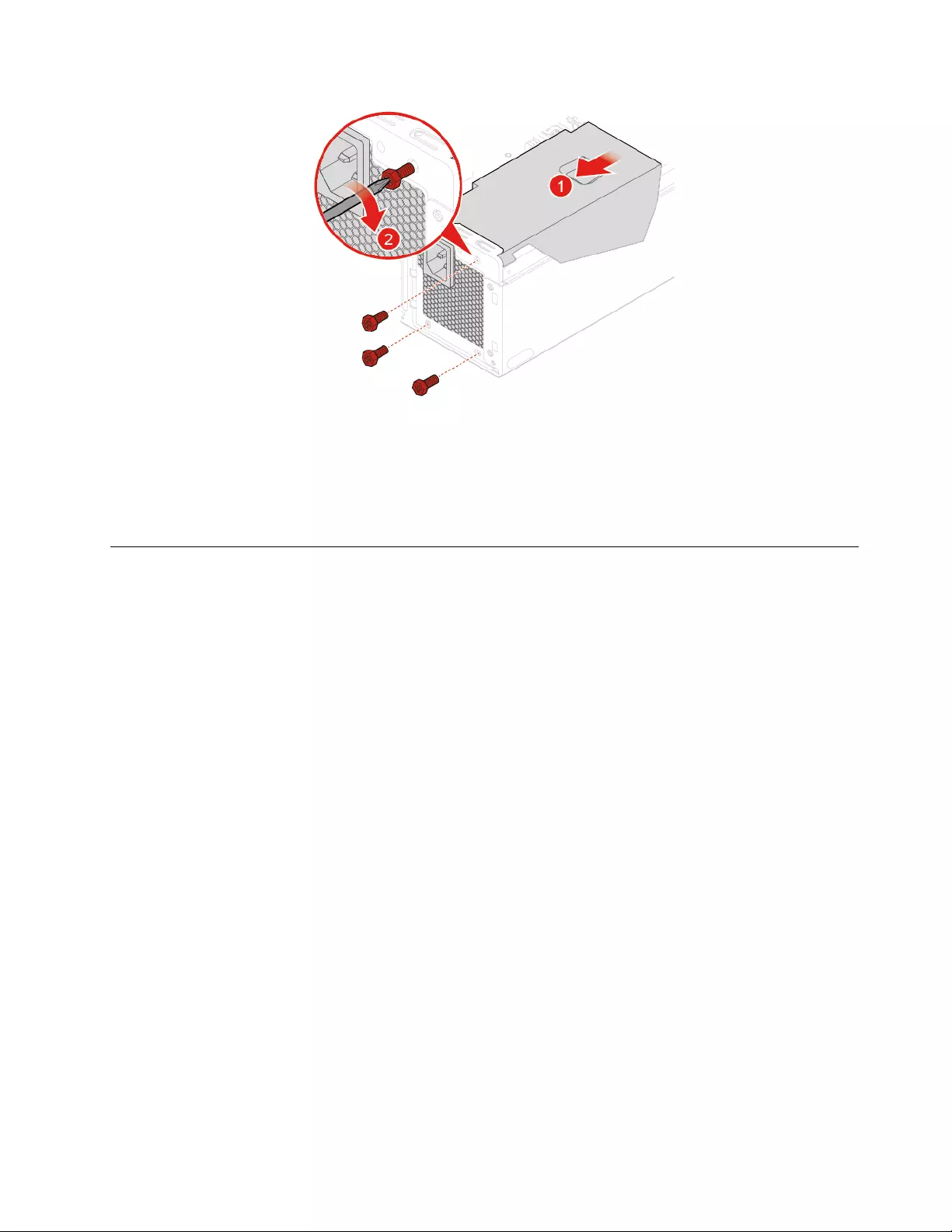
Figure 109. Installing the power supply assembly
7. Connect the new power supply assembly cable to the system board.
8. Reinstall the removed parts. To complete the replacement, see “Completing the parts replacement” on
page 62.
Replacing the system board
Attention: Do not open your computer or attempt any repairs before reading the Important Product
Information Guide.
1. Remove any media from the drives and turn off all connected devices and the computer. Disconnect all
power cords from electrical outlets and disconnect all cables from the computer.
2. Remove the computer cover. See “Removing the computer cover” on page 19.
3. Remove the front bezel. See “Replacing the front bezel” on page 20.
4. Remove the front I/O options. See “Replacing the front I/O options” on page 31.
5. Pivot the drive bay assembly upward. See “Pivoting the drive bay assembly upward and downward” on
page 23.
6. Remove all memory modules. See “Replacing the memory module” on page 40.
7. Remove the heat sink and fan assembly. See “Replacing the heat sink and fan assembly” on page 41.
8. Remove the microprocessor. See “Replacing the microprocessor” on page 43.
9. Remove all PCI Express cards. See “Replacing a PCI Express card” on page 45.
10. Remove the Wi-Fi card. See “Replacing the Wi-Fi card” on page 48.
11. Remove the M.2 storage drive. See “Replacing the M.2 storage drive” on page 56.
12. Record the cable routing and cable connections, and then disconnect all cables from the system board.
See “System board” on page 5.
Chapter 4.Replacing hardware 61

13. Replace the system board.
Notes:
• The numbers in the following figure show the locations of the screws instead of the removing and
reinstalling order of the screws.
• Handle the system board carefully by its edges.
Figure 110. Removing the system board
14. Route all the cables that you disconnected from the failing system board, and then reconnect the cables
to the new system board. See “System board” on page 5.
15. Reinstall the removed parts. To complete the replacement, see “Completing the parts replacement” on
page 62.
Completing the parts replacement
After completing the installation or replacement for all parts, reinstall the computer cover and reconnect the
cables.
To reinstall the computer cover and reconnect the cables to your computer, do the following:
1. Ensure that all components have been reassembled correctly and that no tools or loose screws are left
inside your computer.
2. Ensure that the cables are routed correctly before reinstalling the computer cover. Keep cables clear of
the hinges and sides of the computer chassis to avoid interference when reinstalling the computer
cover.
62 M920s User Guide and Hardware Maintenance Manual

3. Reinstall the computer cover.
Figure 111. Reinstalling the computer cover
4. Place the computer in an upright position.
5. If a locking device is available, use it to lock the computer.
6. Reconnect the external cables and power cords to the corresponding connectors on the computer.
Chapter 4.Replacing hardware 63

64 M920s User Guide and Hardware Maintenance Manual

Appendix A. Notices
Lenovo may not offer the products, services, or features discussed in this document in all countries. Consult
your local Lenovo representative for information on the products and services currently available in your
area. Any reference to a Lenovo product, program, or service is not intended to state or imply that only that
Lenovo product, program, or service may be used. Any functionally equivalent product, program, or service
that does not infringe any Lenovo intellectual property right may be used instead. However, it is the user's
responsibility to evaluate and verify the operation of any other product, program, or service.
Lenovo may have patents or pending patent applications covering subject matter described in this
document. The furnishing of this document does not give you any license to these patents. You can send
license inquiries, in writing, to:
Lenovo (United States), Inc.
1009 Think Place - Building One
Morrisville, NC 27560
U.S.A.
Attention: Lenovo Director of Licensing
LENOVO PROVIDES THIS PUBLICATION "AS IS" WITHOUT WARRANTY OF ANY KIND, EITHER EXPRESS
OR IMPLIED, INCLUDING, BUT NOT LIMITED TO, THE IMPLIED WARRANTIES OF NON-INFRINGEMENT,
MERCHANTABILITY OR FITNESS FOR A PARTICULAR PURPOSE. Some jurisdictions do not allow
disclaimer of express or implied warranties in certain transactions, therefore, this statement may not apply to
you.
This information could include technical inaccuracies or typographical errors. Changes are periodically made
to the information herein; these changes will be incorporated in new editions of the publication. Lenovo may
make improvements and/or changes in the products and/or the programs described in this publication at any
time without notice.
The products described in this document are not intended for use in implantation or other life support
applications where malfunction may result in injury or death to persons. The information contained in this
document does not affect or change Lenovo product specifications or warranties. Nothing in this document
shall operate as an express or implied license or indemnity under the intellectual property rights of Lenovo or
third parties. All information contained in this document was obtained in specific environments and is
presented as an illustration. The result obtained in other operating environments may vary.
Lenovo may use or distribute any of the information you supply in any way it believes appropriate without
incurring any obligation to you.
Any references in this publication to non-Lenovo Web sites are provided for convenience only and do not in
any manner serve as an endorsement of those Web sites. The materials at those Web sites are not part of the
materials for this Lenovo product, and use of those Web sites is at your own risk.
Any performance data contained herein was determined in a controlled environment. Therefore, the result
obtained in other operating environments may vary significantly. Some measurements may have been made
on development-level systems and there is no guarantee that these measurements will be the same on
generally available systems. Furthermore, some measurements may have been estimated through
extrapolation. Actual results may vary. Users of this document should verify the applicable data for their
specific environment.
© Copyright Lenovo 2018, 2019 65

66 M920s User Guide and Hardware Maintenance Manual

Appendix B. Trademarks
LENOVO, LENOVO logo, and the THINKCENTRE logo are trademarks of Lenovo. DisplayPort is a trademark
of the Video Electronics Standards Association. USB-C is a trademark of USB Implementers Forum. All other
trademarks are the property of their respective owners. © 2019 Lenovo.
© Copyright Lenovo 2018, 2019 67

68 M920s User Guide and Hardware Maintenance Manual



